Definition
A transition is said to be external when it exits its source state. Otherwise, the transition is said to be local.
Exiting a state causes:
- (for composite states only) the active states to be exited;
- the execution of the exit action, if any.
Entering a state causes:
- the execution of the entry action, if any;
- (for composite states only) the initial states to be entered.
A transition to a sibling state or to the superstate is inevitably external, as the source state must be exited to allow the target state to be entered. However, in the case of a transition to a substate, or a self-transition, things can be different.
Case #1: Transition to Substate
An external transition from S to its substate T looks like this:
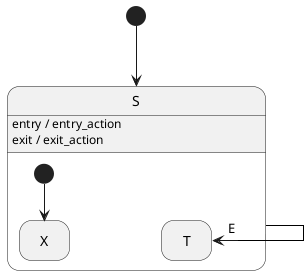
In this example, whenever S is active and the event E occurs, the state machine:
- exits the active substate of S, whatever it is;
- executes exit_action;
- executes entry_action;
- enters T.
Now, let's change this example a bit by making the transition from S to T local:
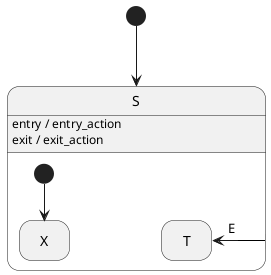
In this new example, whenever S is active and the event E occurs, the state machine:
- exits the active substate of S, whatever it is;
- enters T;
that is, the same steps as with an external transition, except the 2nd and 3rd ones, because S is neither exited nor reentered.
A local transition to a substate can be seen as an external transition from any state of the region to a target state of the same region. As it happens, the notation below is also valid:
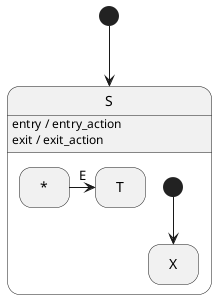
Other regions, if any, are not affected.
Case #2: Self-Transition
An external transition from ST to itself looks like this:
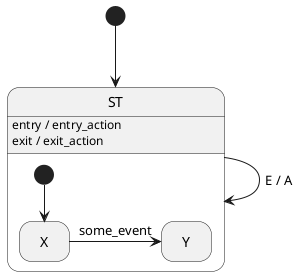
In this example, whenever ST is active and the event E occurs, the state machine:
- exits the active substate of ST, whatever it is;
- executes exit_action;
- executes the action A;
- executes entry_action;
- enters X.
Now, let's change this example a bit by making the transition from ST to itself local:
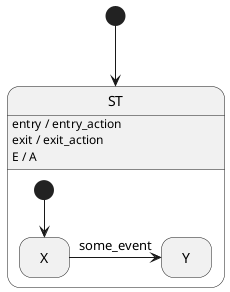
In this new example, whenever ST is active and the event E occurs, the state machine:
- executes the action A;
that is, only the 3rd step of the equivalent external transition, because ST is neither exited nor reentered.
The special case of a local self-transition is called an internal transition. The action associated to an internal transition is called an internal action.
How to Define a Local Transition with Maki
Within Maki, all transitions are external by default. You can express local transitions for the two cases we've seen.
Case #1: Local Transition to Substate
State sets extend the concept of local transitions to substates; a transition whose source state is maki::all_states is the equivalent of such a transition:
Case #2: Internal Transition
In the transition table, you can pass maki::null in lieu of a target state to define an internal transition:
You can also implicitly create a guardless internal transition (which would be prepended to the transition table of the parent region) by adding an internal action to the mold of the state: